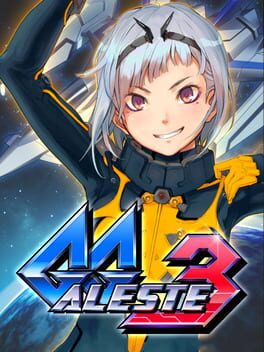Played during the Backloggd’s Game of the Week (19th Sep. – 25th Sep., 2023).
In 2008, M2 developed a remake of Fantasy Zone II: The Tears of Opa-Opa (1987), reinterpreting the title on System16, one of Sega's arcade boards, whose only modification was the addition of some RAM. This philosophy, at the crossroads of nostalgia, authenticity and creativity born of technical limitations, is perhaps what largely informed the development of the Aleste Collection (2020). Rather limited in scope, the compilation lacks some beloved titles such as Musha Aleste (1990) and Super Aleste (1992), but perhaps the idea was to focus on the transformation the series underwent with the transition onto the Game Gear. The console's technical capabilities mechanically mellowed the series' difficulty, and it was this aspect that Manabu Namiki wanted to emulate for this unique sequel [1].
The title feels like a tribute to another era of shoot'em ups that preceded the success of the CAVE titles. Although GG Aleste 3 never achieves the extraordinary difficulty of danmaku games, the title does offer some engaging sequences thanks to its visual atmosphere and mastery of the Game Gear. The high quality of the assets almost makes it easy to forget that this is an 8-bit game, the most obvious expressions of which are the tone of the sound chip and the inevitable slowdowns caused by such a demanding title. This Game Gear spirit also accounts for the relative simplicity of the enemy patterns: the Special mode certainly requires a more cautious strategy, since the enemy fires a revenge bullet after being killed, thus neutralising some of the secondary weapons, but GG Aleste 3 never feels difficult or unfair.
Some sequences can drag on a little too long, but GG Aleste 3 makes up for it with some impressive setpieces. Wave 5 is particularly effective, with the missile's ascent and the air currents creating actual dogfights. There is something anachronistically delicious about the contrast between the soaring cinematography of this chapter and the antiquated hardware. In an interview, the creators were asked to reflect on the state of shoot'em ups in the Reiwa era. GG Aleste 3 is probably less a revolutionary contribution than a statement in favour of diversifying the concepts explored, especially when compared to independent productions. Nakimi concludes with the following observation: 'I think that freedom and breadth of action have been central concepts for shoot'em ups, but that they have been forgotten. [Nowadays] there are so many games where enemies shoot fireworks that you have to avoid, there is no reason for us to make another one – and the Game Gear would not be able to run it anyway. We were not trying to go back in time, but rather provide a variety of flavours' [2].
__________
[1] '『GGアレスタ』シリーズ大鼎談! シリーズのキーマン小玉氏、並木氏、ナカシマ氏が裏話を語り尽くす', on Dengeki Online, 14th January 2021, consulted on 25th September 2023.
[2] Ibid (personal translation).
In 2008, M2 developed a remake of Fantasy Zone II: The Tears of Opa-Opa (1987), reinterpreting the title on System16, one of Sega's arcade boards, whose only modification was the addition of some RAM. This philosophy, at the crossroads of nostalgia, authenticity and creativity born of technical limitations, is perhaps what largely informed the development of the Aleste Collection (2020). Rather limited in scope, the compilation lacks some beloved titles such as Musha Aleste (1990) and Super Aleste (1992), but perhaps the idea was to focus on the transformation the series underwent with the transition onto the Game Gear. The console's technical capabilities mechanically mellowed the series' difficulty, and it was this aspect that Manabu Namiki wanted to emulate for this unique sequel [1].
The title feels like a tribute to another era of shoot'em ups that preceded the success of the CAVE titles. Although GG Aleste 3 never achieves the extraordinary difficulty of danmaku games, the title does offer some engaging sequences thanks to its visual atmosphere and mastery of the Game Gear. The high quality of the assets almost makes it easy to forget that this is an 8-bit game, the most obvious expressions of which are the tone of the sound chip and the inevitable slowdowns caused by such a demanding title. This Game Gear spirit also accounts for the relative simplicity of the enemy patterns: the Special mode certainly requires a more cautious strategy, since the enemy fires a revenge bullet after being killed, thus neutralising some of the secondary weapons, but GG Aleste 3 never feels difficult or unfair.
Some sequences can drag on a little too long, but GG Aleste 3 makes up for it with some impressive setpieces. Wave 5 is particularly effective, with the missile's ascent and the air currents creating actual dogfights. There is something anachronistically delicious about the contrast between the soaring cinematography of this chapter and the antiquated hardware. In an interview, the creators were asked to reflect on the state of shoot'em ups in the Reiwa era. GG Aleste 3 is probably less a revolutionary contribution than a statement in favour of diversifying the concepts explored, especially when compared to independent productions. Nakimi concludes with the following observation: 'I think that freedom and breadth of action have been central concepts for shoot'em ups, but that they have been forgotten. [Nowadays] there are so many games where enemies shoot fireworks that you have to avoid, there is no reason for us to make another one – and the Game Gear would not be able to run it anyway. We were not trying to go back in time, but rather provide a variety of flavours' [2].
__________
[1] '『GGアレスタ』シリーズ大鼎談! シリーズのキーマン小玉氏、並木氏、ナカシマ氏が裏話を語り尽くす', on Dengeki Online, 14th January 2021, consulted on 25th September 2023.
[2] Ibid (personal translation).
